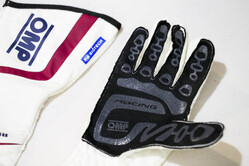 Sergey Sirotkin and Charles Leclerc are not the only newcomers on the grid this weekend, for besides the Halo device, the Australian Grand Prix sees the introduction of another important safety initiative from the FIA.
Sergey Sirotkin and Charles Leclerc are not the only newcomers on the grid this weekend, for besides the Halo device, the Australian Grand Prix sees the introduction of another important safety initiative from the FIA.
Starting from this weekend, the FIA is introducing a new race glove that sends potentially life-saving data from driver to medical crew.
The gloves will be worn by every F1 driver and monitor their vital signs during the race via a flexible 3mm sensor stitched into the palm area of the fabric.
The FIA has worked closely with F1 glove manufacturers Puma, OMP, Alpinestars and Sparco to integrate these sensors into fire-resistant clothing for the first time.
According to the FIA, initially the optical sensor will measure 'pulse oximetry', or the amount of oxygen in the blood, alongside the pulse rate, enabling the trackside medical team to receive important information as soon as there is an incident. This is potentially important in the context of a racing driver because if they have an injury that is affecting breathing, the oxygen content of the blood will diminish rapidly.
Driver safety is of paramount importance for the FIA, and together with its Research Body, Global Institute, alongside its doctors and engineers, it has been examining how state-of-the-art technology could help medical teams and drivers.
Biometric data helps to assess the driver's conditions before, at the time of the crash and after the crash as far as the rescue operations are concerned. Further developments in this area are planned throughout the season to improve the device and set new benchmarks for motor sport safety."
The project is the result of a partnership between the Global Institute and Signal Biometrics Ltd, the company set up by Dr Ian Roberts and the engineer Alain van der Merwe, who have both been involved in F1 with the FIA for many years respectively as Deputy Medical Delegate and Medical Car Driver.
"We know that the monitoring of people is essential in terms of their medical care and drivers in incidents are no different," said Roberts. "We would like to start monitoring and assessing them as soon as we possibly can. There are also times when the driver isn't immediately accessible to us, so if we can't see him or we're not actually next to him, there's limited information that we can get."
Carlos Sainz' accident during the 2015 Russian GP is a case in point. The Spaniard lost control of his Toro Rosso at Turn 13 during the third practice session and hit the barrier head-on at 153km/h. Fortunately, he was unhurt but it was difficult for the F1 medical team to know this, as the first row of the barrier came to rest on top of the driver. Consequently, when they arrived at the scene, they found that they had limited contact with him and had to wait until the barrier was removed from the car before a more direct medical assessment could begin.
With this new technology, the moment a driver has an incident the trackside medical team will receive physiological readings and biometrics, so he is continually monitored from point zero right through to the initial response and on to the medical centre.
"This will enable monitoring of the driver not only when still in the car, but also offer the benefit of continuous monitoring during patient transport," said van der Merwe.
Going forward, there are already plans to implement sensors for respiratory rate and temperature. In addition to the safety benefits, these will help teams and drivers with performance monitoring. Respiratory rate gives a very good indication of a driver's state of health and stress, while temperature is well known for affecting performance.
F1 is the first step for the device in motor sport as the idea is expected to filter down to other championships.
Check out our Friday gallery from Melbourne, here.






















sign in